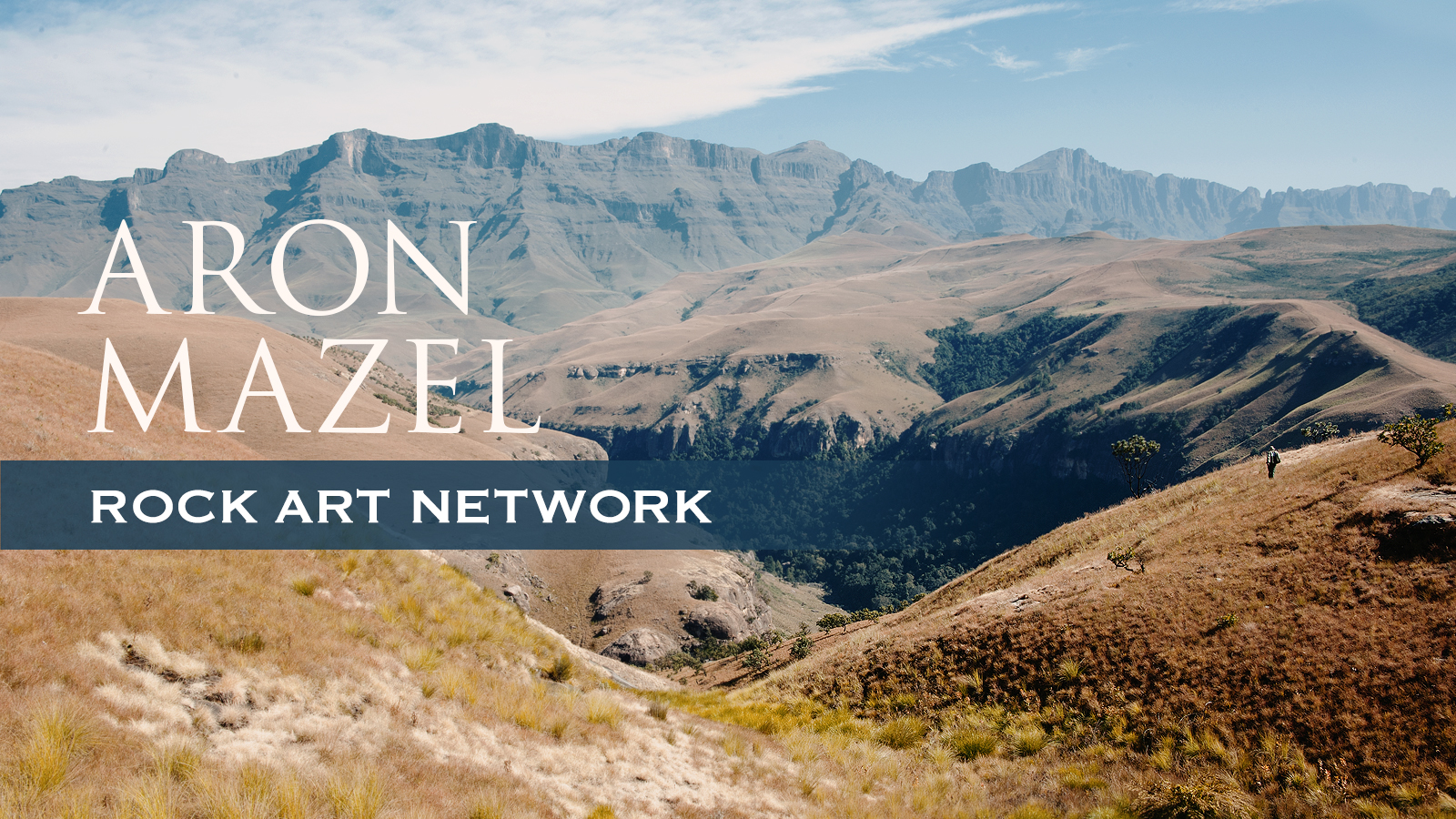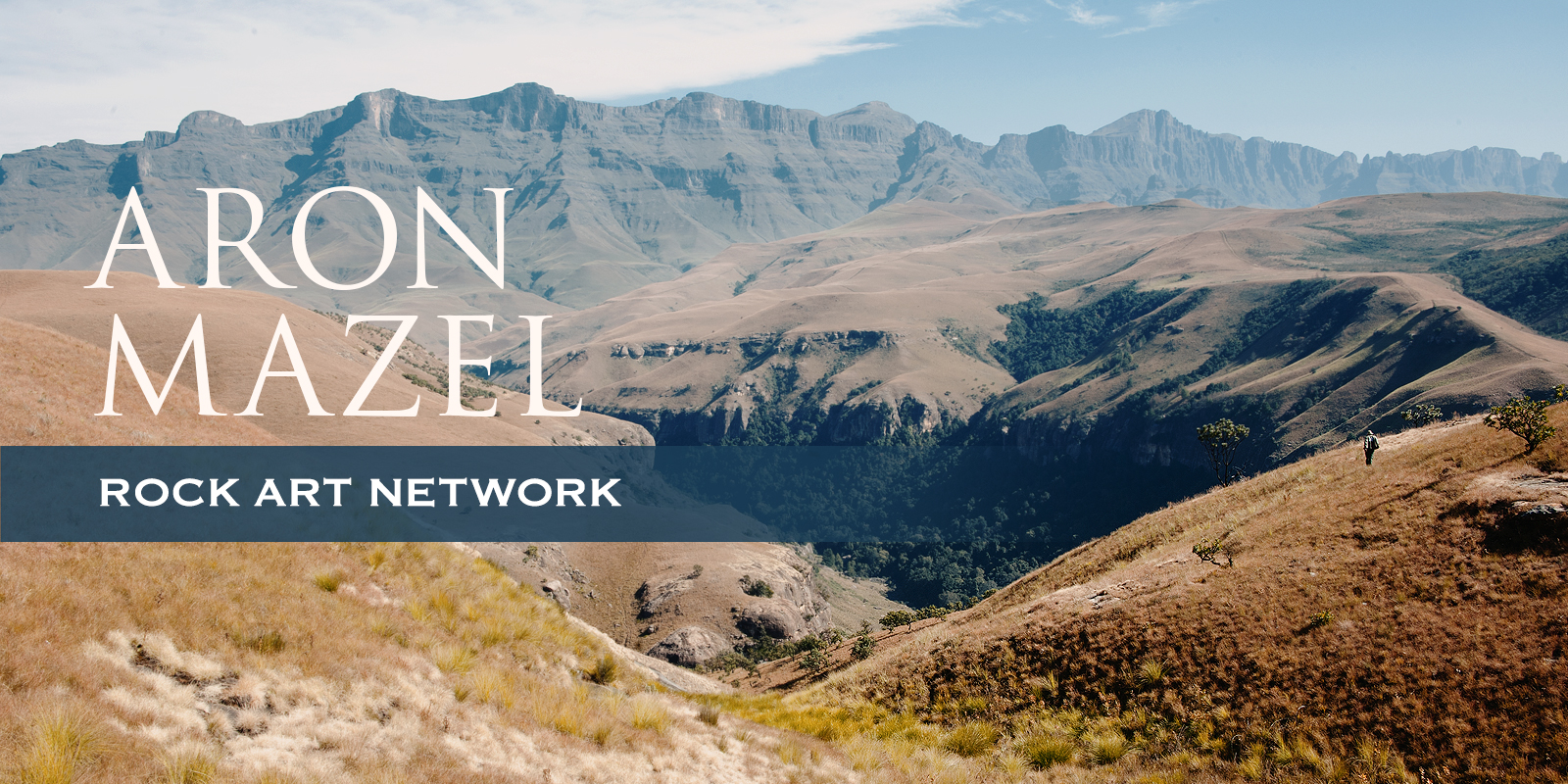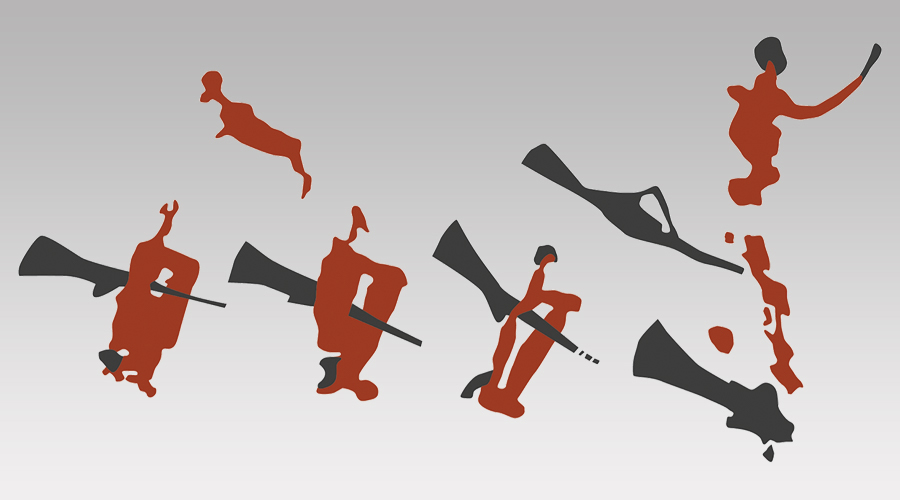


by Aron Mazel
Lecturer, Newcastle University
This article was originally published in the April 2018 issue of 'The Digging Stick' Volume 35, No 1. ISSN 1013-7521
View of the top end of Didima Gorge and the high uKhahlamba-Drakensberg mountains
From a cultural perspective, UNESCO based the WHS designation on two Outstanding Universal Values: a) it is ‘the largest and most concentrated group of rock paintings in Africa south of the Sahara and is outstanding both in quality and diversity of subject’ and b) the San occupied the region ‘for more than four millennia, leaving behind them a corpus of outstanding rock art which throws much light on their way of life and their beliefs’ (UNESCO 2018). This international recognition gives cause for us to celebrate the exceptional nature of the uKD rock paintings.
The question needs to be asked, however, what makes it so special? Extensive recording during the last 50 years has revealed about 40 000 individually painted images in over 600 rock shelters. Mostly painted by San hunter-gatherers, the number of paintings in individual sites varies greatly, from only one image in some instances to more than a 1 000 in four sites. One such site is Eland Cave in the northern uKD where Pager (1971) counted 1 639 individual images (Figure 2). Complementing the abundance of imagery is the remarkable detail with which they were painted. Occasionally there are human figures with toes, fingers, facial features and hairs, while animal figures were sometimes painted with eyes and hairs standing on end (Figure 3). Elements of material culture, such as musical instruments, bows and arrows, and digging sticks are also represented.
Interpretation of ethnographic insights provided by San people during the 19th and 20th centuries have revealed that the paintings are deeply imbued with symbolic meaning, reflecting the San’s belief systems and the visions of shamans in trance (e.g. Lewis-Williams 1981, 2003). Supporting this framework is the presence of a significant number of explicitly shamanistic paintings, such as therianthropes and trance buck (Figure 4). Advances in absolute and relative dating since the 1990s have shown that the San uKD painting tradition is older than previously thought, going back at least 3 000 years or perhaps slightly earlier.
While the rock paintings are celebrated for their quality, quantity, diversity and age, they are a vulnerable and threatened cultural resource. Vandalism of the paintings was noticed already in the 1800s. Significantly, the country’s first heritage legislation, the Bushman Relics Act 1911 was largely influenced by an outcry over the defacement, destruction and export of rock art (Figure 5). At roughly the same time as this Act was promulgated, we see the first significant rock art management intervention in the uKD, with the recording of about 40 sites and the removal of panels to the Natal, now the KwaZulu-Natal Museum (KZNM), for safekeeping. Despite these early concerns and actions, it was only in the 1970s that a concerted safeguarding endeavour for uKD rock paintings was initiated. The Directorate of Forestry (DoF), which managed most of the uKD at the time, established ‘A survey of the Rock Art in the Natal Drakensberg’ project. RAND in short, the project continued from 1978 to 1981. As it is now 40 years since the start of the project, it is appropriate to reflect on the project and its purpose.
1 This paper is dedicated to the memory of Val Ward, who sadly passed away in 2017.
Close up of an eland at Game Pass 1 showing its eyes clearly demarcated and hairs standing on end
Pager’s meticulous study contributed to the establishment in the 1970s of a DoF advisory committee to consider the recording and management of uKD rock art. The committee acknowledged that the DoF lacked the appropriate data on which to base a long-term safeguarding plan for the paintings. The considerable rock art recording of the previous two decades had not always generated information that was consistent and of sufficient detail on which to base a management plan. Furthermore, there were large areas of the uKD that had not been adequately surveyed. The committee agreed to the establishment of comprehensive rock painting recording project to remedy the situation. Funds for the project were granted in 1978 with the aim: ‘To obtain accurate and detailed information on the rock art and Later Stone Age deposits that occur in many rock shelters in the Natal Drakensberg. This information is primarily intended for management planning, but it is also of importance as pure research and as permanently stored data’ (Anonymous nd). Tim Maggs at the KZNM agreed to supervise the RAND project and the museum provided facilities and space. RAND was divided into two phases with Val Ward doing Phase 1 from June 1978 to March 1979, and I handling Phase 2 from January 1979 to April 1981.
The site report form used by the KZNM formed the basis of the recording process. It required the completion of information such as site category, the map reference, directions to the site, and a description of the archaeological content, e.g. rock art, surface artefacts and potential archaeological deposits. Detailed descriptions of the paintings were written, beginning on the left of the shelter and working towards the right. Paintings were described individually and in relationship to each other. Extensive colour-slide and monochrome photographs were taken to support the written records, but time constraints meant that only a limited amount of tracing was done. Sites were plotted on 1:50 000 maps and, where possible, on overlays of 1:20 000 colour aerial photographs. A management data questionnaire, formulated by representatives of the DoF, the Natal Parks Board (NPB), KZNM and I, was completed at individual sites during Phase 2. Finally, Dymo stainless steel strips with site numbers were fixed with epoxy glue to the bottom left of each rock shelter.
At the beginning of RAND there was no indication of the total number of known uKD painted sites. At the completion of Phase l, 433 painted sites and 40 non-art sites were on record. During this phase, 24 sites and 1 801 paintings in the central uKD were fully recorded with the help of members of the South African Archaeological Society.
The strategy adopted for this phase was to start recording at the Royal Natal National Park (RNNP) in the north and to work south to Bushman’s Nek. At the outset, it was evident that it would be impossible to fully explore and record rock art in the whole uKD, including the area between the RNNP and Cathedral Peak, known at the time as the Upper Tugela Location (UTL). A set of priorities was therefore established based on, firstly, selecting those areas to be focused on and, secondly, ranking zones within these areas. Regarding the first priority, precedence was given to DoF land as they had funded the project and then to NPB areas. It was not possible, for a variety of reasons, to work in the UTL and on private land. Within the targeted areas, the high-intensity use areas identified by conservation officials were prioritised along with access routes within the low intensity use areas, as these faced the greatest threats of vandalism.
Therianthropic figure at Cyprus 2. Note its animal face with a tusk, hairs standing on end, and hooves
In total, 412 sites were recorded during RAND, of which 388 were recorded during Phase 2. On completion of the project, 604 archaeological sites were known in the uKD, including 516 painted sites and 88 non-art sites. Close on 70 per cent of all known sites at the time were now recorded and 20 668 paintings had been described and photographed, 18 867 of them in Phase 2. Some 3 748 paintings (18 per cent) were derived from newly recorded sites, with 2 529 (67 per cent) from south of Giants Castle and 1 219 (23 per cent) from Giants Castle and north thereof. Viewed from a different perspective, the number of known paintings was increased by six per cent in the north and about 20 per cent in the south.
The final project report, entitled ‘Up and down the Little Berg: archaeological resource management in the Natal Drakensberg’ (Mazel 1981), fulfilled the project’s mandate to record known paintings in a specified area and develop a plan for the management of uKD rock art. It was the first rock art plan to be produced in South Africa.
While RAND lasted for only about three years, which was the period of funding, it has had a lasting influence on South African archaeology and heritage, especially in the uKD. Of particular significance is that it highlighted the extent of the uKD painted record. Although its painting tradition was well known prior to RAND, we did not know at the time that the uKD boasted over 500 painted sites and 30 000 paintings. These details were instrumental in the uKD being designated a WHS. Notably, the first point about rock art in the 1999 WHS nomination dossier stated that the ‘area is the most densely painted, significantly large area on the African continent … number of sites is estimated at 600 and the number of individual images in those probably exceeds 35 000’ (KwaZulu-Natal Conservation Service and Amafa aKwazulu Natali-Heritage 1999).
In the last decade, two projects have updated the uKD rock art records, namely the African Conservation Trust’s (ACT) Rock Art Mapping Project from 2010 to 2012 (Nardell 2012), and Tommy Topp (2011) and his volunteer team. RAND site information was used extensively for these projects. Not only were RAND sites re-recorded but many new ones were discovered. Now, we have on record over 600 painted sites, including many in the UTL.
Although the RAND management plan was well received by DoF and NPB officials, it was not implemented in the 1980s, and the committee established to oversee this process was short-lived (Mazel 2012). Neither conservation agencies made the necessary resources available to realise the plan. However, in the 1990s things began to change. In 1993, the NPB assumed control of DoF land in the uKD. At about the same time, the alarm was raised when campers were discovered to be sleeping adjacent to paintings in Fergies Cave and leaving candle wax close to the art, even though the NPB had been requested, in the early 1980s, to stop people camping in the site. The observation heralded a new phase in uKD rock art management. A Rock Art Advisory Committee (RAAC) was established, under the auspices of the NPB to focus on rock art management. This included dealing with public interpretation and educating NPB management personnel about the significance and vulnerability of the paintings.
Furthermore, it led to the creation in 1998 of a new uKD cultural heritage management plan, which became known as CURE (Wahl et al. 1998). This plan drew substantially on the RAND plan. Since the development of the CURE plan, rock art management in the uKD has had its up and downs, especially as regards Ezemvelo’s2 commitment to it (Mazel 2012, 2018). Of particular concern has been Ezemvelo’s failure to appoint a cultural heritage specialist to focus on rock art management. The body contends that this is because of financial constraints, but it has been argued that the reasons run far deeper, with the underlying ethos of the organisation strongly focused on natural history rather than on cultural matters (Mazel 2012, 2018). Part of the way Ezemvelo has dealt with the lack of in-house heritage personnel, its responsibilities towards the uKD’s WHS status and the management of cultural heritage was to sign a Memorandum of Understanding (MoU) (1999) with Amafa, the provincial heritage agency. This committed both parties to ‘cultural resources conservation’ in the uKD. The MoU is still in place. Ezemvelo is currently in the process of implementing the rock art clustering management programme devised by Topp and it appears that the organisation is more committed than previously to safeguarding rock art. Such initiatives could, however, come to nought in the forthcoming years with the absence of a cultural heritage specialist within Ezemvelo to drive them forward. This is an ongoing risk, given that the ACT and Topp projects have revealed that the deterioration of the rock paintings is ongoing, with some or perhaps even much of the risk and damage resulting from human agency.
In addition to the recording of the rock art, excavations conducted as part of RAND laid the platform for an enlarged excavation programme. Following RAND, I developed an extensive Holocene Later Stone Age excavation programme in the Thukela basin, which included the northern uKD. Initially, this involved expanding the excavations at Diamond 1 and Clarke’s Shelter in 1981 (Mazel 1984). Subsequently, Mhlwazini Cave was excavated in 1987 (Mazel 1990) and Collingham Shelter in 1988 (Mazel 1992). These sites, together with Driel Shelter on the outskirts of the uKD, which Maggs and Ward (1980) excavated in 1974, have widened and deepened our knowledge of San occupation in the northern uKD (Wright and Mazel 2007). Results show that the San first occupied the northern uKD about 5 000 years ago although this occupation appears to be ephemeral until about 3 000 years ago. Thereafter, the San appear to have intensified their occupation of the northern uKD until 1 600 years ago, as revealed by the greater number of inhabited rock shelters, the increased quantities and range of food and cultural remains recovered from the excavations, and the dating of rock paintings. Some 1 600 years ago the San largely abandoned the northern uKD and relocated to the central Thukela basin, which had recently been inhabited by farming communities. Then, around 600 years ago, the San resumed their occupation of the northern uKD at roughly the same time the farmers began occupying the neighbouring uplands. It is likely that the San’s return to the mountains was associated with the arrival of the farmers in the adjacent area.
Following the completion of the RAND project, the KZNM established a Stone Age archaeology post in 1981. The creation of a rock art position followed this.
2 The KwaZulu-Natal Nature Conservation Service is the provincial statutory body responsible for the management of protected areas in terms of the KwaZulu-Natal Nature Conservation Management Act No. 9 of 1997. It was formed in 1998 through the amalgamation of the NPB and the KwaZulu Department of Nature Conservation. Ezemvelo is the brand name for this body.
As reflected above, the RAND project revealed the magnitude of the uKD rock art assemblage, laid the platform for the management of uKD rock art and developed our knowledge of the area’s San archaeological past through rock shelter excavations. It taught me as a young archaeologist to take nothing for granted as a question often posed to me before I surveyed certain areas was: ‘But surely this area has been investigated before. Is there a need to cover it again?’ Here, the results speak for themselves as not only did we substantially increase the number of known sites during RAND, but significantly more have been discovered with ongoing surveys. Moreover, it showed me that putting together a plan does not mean that it will be followed by funding and implementation. These might require pressurising the authorities over a long period of time.
Anonymous. nd. Proposed Sub Project Description: A survey of the rock art in the Natal Drakensberg. Reference 1/3/10/03/02. Conservation Forestry Research.
Kwazulu-Natal National Conservation Service & Amafa aKwazulu Natali-Heritage. 1999. Nomination proposal for the Drakensberg Park alternatively known as uKhahlamba Park to be listed as a World Heritage Site. KwaZulu-Natal Museum records.
Lewis-Williams, JD. 1981. Believing and Seeing: Symbolic Meanings in Southern San Rock Painting. London: Academic Press.
Lewis-Williams, JD. 2003. Images of Mystery: Rock Art of the Drakensberg. Cape Town: Double Storey.
Maggs, T & Ward, V. 1980. Driel Shelter: rescue at a Late Stone Age site on the Thukela River. Annals of the Natal Museum 24: 35–70.
Mazel, AD. 1981. Up and down the little berg: archaeological resource management in the Natal Drakensberg. Final Project Report to the Department of Water Affairs, Forestry and Environmental Conservation. Unpublished report. Pietermaritzburg.
Mazel, AD. 1984. Diamond 1 and Clarke's Shelter: report on excavations in the northern Drakensberg, Natal, South Africa. Annals of the Natal Museum 26: 25–70.
Mazel, AD. 1990. Mhlwazini Cave: the excavation of late Holocene deposits in the northern Natal Drakensberg, Natal, South Africa. Natal Museum Journal of Humanities 2: 95–133.
Mazel, AD. 1992. Collingham Shelter: the excavation of late Holocene deposits, Natal, South Africa. Natal Museum Journal of Humanities 4: 1–52.
Mazel, AD. 2012. Safeguarding a fragile legacy: the management of uKhahlamba-Drakensberg rock art. In J McDonald & P Veth (eds), Companion to Rock Art, Chichester: Wiley-Blackwell Publishing Ltd, 515–531.
Mazel, AD. 2018. Managing the rock art of the uKhahlamba-Drakensberg: progress, blind spots and challenges. In Makuvaza, S (ed.), Aspects of Management Planning for Cultural World Heritage Sites: Principles, Approaches and Practices. Cham: Elsevier: 131–146.
Memorandum of Understanding between KwaZulu-Natal Nature Conservation Service and Amafa aKwaZulu Natali. 1999. Pietermaritzburg.
Nardell, V. 2012. Final RAMP2 rock art documentation report, December 2012. Unpublished document. Pietermaritzburg.
Pager, H. 1971. Ndedema: A Documentation of the Rock Paintings of the Ndedema Gorge. Graz: Akademische Druck.
Pager, H. 1973. Report on the deterioration of the rock paintings of the Ndedema Gorge, Cathedral Peak area, Natal Drakensberg. Unpublished Report. Pietermaritzburg: Department of Forestry.
Topp, T. 2011. Brief summary of the rock art verification in the UKhahlamba-Drakensberg Park World Heritage Site. Unpublished report.
UNESCO. 2018. Maloti-Drakensberg Park. http://whc.unesco.org/ en/list/985 (accessed 20/01/ 2018).
Vinnicombe, P. 1976. People of the Eland. Pietermaritzburg: University of Natal Press.
Wahl, EJ, Mazel, AD & Roberts, SE. 1998. Participation and education: developing a cultural resource plan for the Natal Drakensberg Park, KwaZulu-Natal, South Africa. Natal Museum Journal of Humanities 10: 151–170.
Wright, JB & Mazel, AD. 2007. Tracks in a Mountain Range: Exploring the history of the Ukhahlamba-Drakensberg. Johannesburg: Wits University Press.
→ Aron Mazel is with the Newcastle University, United Kingdom, and the University of the Witwatersrand, South Africa. aron.mazel@ncl.ac.uk
→ Animals in Rock Art
→ San rock art exhibition at the National Museum & Research Center of Altamira
→ Discover more about the Rock Art of South Africa
→ Discover more about the Rock Art of Africa
→ Members and affiliated institutions of the Rock Art Network
by
George Nash
5/09/2024 Recent Articles
→ Sigubudu: Paintings of people with guns in the northern uKhahlamba-Drakensberg
by Aron Mazel
22/07/2024
by Richard Kuba
13/06/2024
by Meenakshi Dubey-Pathak
8/03/2024
by Rock Art Network
6/02/2024
by Rock Art Network
14/12/2023
by Sam Challis
5/12/2023
by Aron Mazel
30/11/2023
by Sam Challis
21/11/2023
by Sam Challis
15/11/2023
by Sam Challis
10/11/2023
by Rock Art Network
6/11/2023
by Rock Art Network
3/11/2023
by Aron Mazel
2/11/2023
by Meenakshi Dubey-Pathak
26/09/2023
by Paul Taçon
24/08/2023
by Aron Mazel
13/06/2023
by Paul Taçon
5/06/2023
by Paul Taçon
15/03/2023
by George Nash
14/03/2023
by Noel Hidalgo Tan
10/02/2023
by George Nash
01/02/2023
by Meenakshi Dubey-Pathak, Pilar Fatás Monforte
29/11/2022
by Aron Mazel, George Nash
21/09/2022
by Paul S.C. Taçon, Sally K. May, Ursula K. Frederick, Jo McDonald
07/07/2022
by Meenakshi Dubey-Pathak
26/07/2022
by Paul Taçon
20/07/2022
by David Coulson
16 June 2022
by Paul Taçon
25 April 2022
by Noel Hidalgo Tan
20 April 2022
by Meenakshi Dubey-Pathak
14 March 2022
by Carolyn Boyd & Pilar Fatás
02 March 2022
by David Coulson
07 February 2022
by Johannes H. N. Loubser
06 February 2022
by Meenakshi Dubey-Pathak
05 February 2022
by Aron Mazel
28 January 2022
by Aron Mazel
8 September 2021
by David Coulson
17 August 2021
by Ffion Reynolds
21 June 2021


by Aron Mazel
22/07/2024
by Richard Kuba
13/06/2024
by Meenakshi Dubey-Pathak
8/03/2024
by Rock Art Network
6/02/2024
by Rock Art Network
14/12/2023
by Sam Challis
5/12/2023
by Aron Mazel
30/11/2023
by Sam Challis
21/11/2023
by Sam Challis
15/11/2023
by Sam Challis
10/11/2023
by Rock Art Network
6/11/2023
by Rock Art Network
3/11/2023
by Aron Mazel
2/11/2023
by Meenakshi Dubey-Pathak
26/09/2023
by Paul Taçon
24/08/2023
by Aron Mazel
13/06/2023
by Paul Taçon
5/06/2023
by Paul Taçon
15/03/2023
by George Nash
14/03/2023
by Noel Hidalgo Tan
10/02/2023
by George Nash
01/02/2023
by Meenakshi Dubey-Pathak, Pilar Fatás Monforte
29/11/2022
by Aron Mazel, George Nash
21/09/2022
by Paul S.C. Taçon, Sally K. May, Ursula K. Frederick, Jo McDonald
07/07/2022
by Meenakshi Dubey-Pathak
26/07/2022
by Paul Taçon
20/07/2022
by David Coulson
16 June 2022
by Paul Taçon
25 April 2022
by Noel Hidalgo Tan
20 April 2022
by Meenakshi Dubey-Pathak
14 March 2022
by Carolyn Boyd & Pilar Fatás
02 March 2022
by David Coulson
07 February 2022
by Johannes H. N. Loubser
06 February 2022
by Meenakshi Dubey-Pathak
05 February 2022
by Aron Mazel
28 January 2022
by Aron Mazel
8 September 2021
by David Coulson
17 August 2021
by Ffion Reynolds
21 June 2021
Friend of the Foundation


by Aron Mazel
22/07/2024
by Richard Kuba
13/06/2024
by Meenakshi Dubey-Pathak
8/03/2024
by Rock Art Network
6/02/2024
by Rock Art Network
14/12/2023
by Sam Challis
5/12/2023
by Aron Mazel
30/11/2023
by Sam Challis
21/11/2023
by Sam Challis
15/11/2023
by Sam Challis
10/11/2023
by Rock Art Network
6/11/2023
by Rock Art Network
3/11/2023
by Aron Mazel
2/11/2023
by Meenakshi Dubey-Pathak
26/09/2023
by Paul Taçon
24/08/2023
by Aron Mazel
13/06/2023
by Paul Taçon
5/06/2023
by Paul Taçon
15/03/2023
by George Nash
14/03/2023
by Noel Hidalgo Tan
10/02/2023
by George Nash
01/02/2023
by Meenakshi Dubey-Pathak, Pilar Fatás Monforte
29/11/2022
by Aron Mazel, George Nash
21/09/2022
by Paul S.C. Taçon, Sally K. May, Ursula K. Frederick, Jo McDonald
07/07/2022
by Meenakshi Dubey-Pathak
26/07/2022
by Paul Taçon
20/07/2022
by David Coulson
16 June 2022
by Paul Taçon
25 April 2022
by Noel Hidalgo Tan
20 April 2022
by Meenakshi Dubey-Pathak
14 March 2022
by Carolyn Boyd & Pilar Fatás
02 March 2022
by David Coulson
07 February 2022
by Johannes H. N. Loubser
06 February 2022
by Meenakshi Dubey-Pathak
05 February 2022
by Aron Mazel
28 January 2022
by Aron Mazel
8 September 2021
by David Coulson
17 August 2021
by Ffion Reynolds
21 June 2021
Friend of the Foundation




















